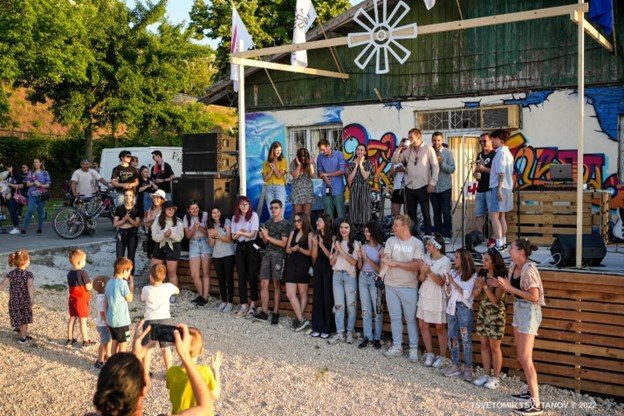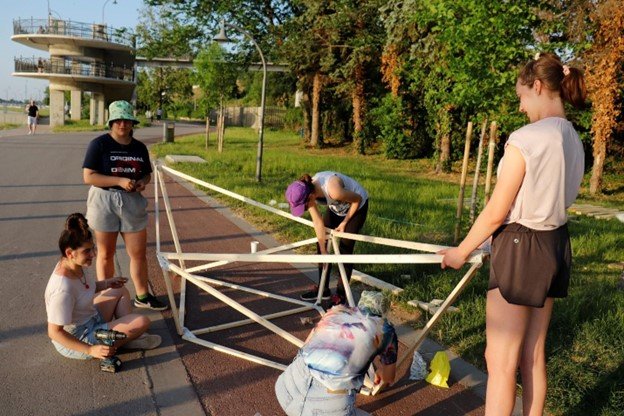Winners in the spotlight 2021: Danube Design Lab

Festival Opening of the redesigned shared place by the Danube River. (Photo by The Collective)
Danube Design Lab is an urban design project using the method of placemaking to engage disengaged youth in the city of Ruse in Northern Bulgaria. The river Danube has been detached from the city since the deindustrialization, which inspired The Collective team to use a disused place by the Danube River for their placemaking activities. They won the Idea Challenge 2021 and have been implementing their project since October 2021. Read more about the Danube Design Lab in the following interview with Ani Kodjabasheva, the director of projects at The Collective.
Your project is located in the town Ruse, Bulgaria, by the river Danube. What should we know about Ruse?
Ruse is a charming town with a rich history and beautiful nature. In the past three decades, it has been experiencing depopulation like other parts of Northern Bulgaria. A lot of young people choose to leave for their studies or start working and building a life elsewhere. Many rusentsi [people from Ruse] are moved by the idea of their city being a vibrant and exciting place again: A place where young people have the opportunity not just to make a living, but to make a difference, and to be part of something cool and transformative together. You often hear the complaint, “Nothing happens in Ruse.” With the project Danube Design Lab, we wanted to change that.
What is the community that you worked with for Danube Design Lab?
The group of young people that we worked with were students in Ruse’s system of vocational high schools – this group of students is being prepared for a variety of professions, from fashion design and sewing to woodworking and shipbuilding. The vocational schools are a great resource, but despite the potential, their students tend to fall behind in the contemporary job market as well as in the sphere of civic engagement. While students from language high schools as well as arts and math schools are presented with a range of opportunities such as festivals, events, volunteering, or afterschool activities, vocational school students lack those opportunities. Vocational schools more often keep to themselves and are considered less prestigious.
Some of our team members in The Collective studied at a vocational school and this helped us connect the dots: These students have amazing skills, both technical and creative, that they could use to engage more actively with civic life in Ruse. All we had to do was to create an opportunity for them to do so.

The project team and the students who participated in the designing process at the opening festival. (Photo by The Collective)
So, how did you come up with the overall idea of Danube Design Lab?
It was simple. As I just mentioned, Ruse has many young people who are not taking part in civic life despite their potential. Ruse also has incredible spaces that are not utilized – especially around the Danube River. As a result, we decided to put disengaged youth together with the disconnected river and an idea was in the making.
We engaged vocational school students in creating a new space by the river using their technical and creative skills. The aim was to create a place where the students themselves, but also other rusentsi could feel a sense of excitement, opportunity and belonging.
What do you think is special about your project approach?
In addition to more commonly known methods – including pedagogy, teamwork, mentorship, active learning – we also used a couple of approaches from architecture and its related disciplines. All the team members from The Collective share a background related to architecture. This gives us a unique approach.
In this project, we used design-build and placemaking methods. In the first step, students work together on teams and turn their ideas into completed designs – and in the second step, we build them. We’ve developed a way to transform spaces with minimal, temporary interventions and a light footprint. We would, for example, use timber frame constructions, plants, lighting, and decoration to completely turn around the look and function of a place. In this way, the transformation is quick, real, and tangible. It was a thrill for students to see different parts of their city be transformed by themselves in only a few months’ time. This method is called placemaking – creating a new, shared, public place.

Students working on the miniature model of the space. (Photo by The Collective)
The magic of these temporary transformations is that, even though the placemaking intervention lasts only for 4 months, it has a permanent effect. People start seeing the place in a new light; they change their perception of it. Once they can see it, touch it, and spend time there, they become aware of what is possible in their city – and that is something that drawings and visualizations alone cannot do. It is not just a proposal that remains on paper, but it is also not a full-scale construction project that takes years and is decided by leaders without involving the public. It is the space of active imagination in-between, where we get to build and experience a new place. This creates a sense that making a difference is possible and easier than you might think.

Students constructing their design on site. (Photo by The Collective)
Any highlights, challenges, and learnings on the way that you would like to share?
After all the efforts of building the place with our own hands, with lots of overtime, working until dark, the opening festival was the biggest highlight to us. We finally had the opportunity to be able to sit around and talk informally to our students in a relaxed atmosphere in the place that we built together.
One challenge was that we couldn’t fully implement all of the ideas. One of the student teams had great proposals of floating structures on the water. Because we are in a port area, this was not possible due to regulations. We opened a pathway down to the water and saw many people relaxing and reflecting alone or in small groups. So, we almost touched the water as the student design suggested. Still, I wish, we would have been able to create the colorful oversized boats proposed by a team that included a student from the shipbuilding school. It’s an idea we’ll keep for future years.
This summer, we saw that the space has potential to remain active for many months. So, our learning for the future is that we will engage students more in creating, designing, and planning events in the new space.

Fire dancers at the opening festival. (Photo by The Collective)
What will be next for you and your team at The Collective?
Our project will become an annual initiative! We will continue working with students on our placemaking activities in Ruse, gradually extending their scope. The goal is to use a series of targeted, temporary interventions to gradually transform the whole riverfront in Ruse and how people relate to it. We want to turn the riverfront into a more active, inclusive, and green civic space.
This agenda is already starting in September 2022. At the moment, we are organizing an event in cooperation with the European Parliament offices in Romania and Bulgaria. Local and EU-level politicians, as well as youth from both Ruse and Bucharest will be invited to work together to create feasible ideas for Ruse’s riverfront. The results of this meeting will be developed further in a series of workshops planned for the coming winter, with the support of the Friedrich Ebert Foundation. Our aim is to show as many people as possible that placemaking and collective urbanism stimulate civic engagement in an accessible, effective, and attractive way.

Design workshop with the students. (Photo by The Collective)
Furthermore, we are already applying for possibilities to take the Danube Design Lab to other cities – starting with Vidin, Bulgaria. There are ongoing conversations with partners in Slovenia and Germany to take our approach to the scale of the whole Danube region – it is still under construction, but there is a lot of potential.
We are also continuing our project Rivers of Sofia. To our delight and surprise, this year it won an Europa Nostra Award / European Heritage Award – the highest distinction for heritage in Europe. Our temporary placemaking initiative was ranked next to multimillion-euro projects by renowned architectural firms. This really demonstrates the potential of playing around with urban space and igniting people’s imaginations. We are also curious to see where else we will take this approach we’ve developed!
Oh, and this July we also launched a new initiative – 100 Stola (100 Chairs). We scavenge for obscure urban spaces that could be opened to the public with greenery, urban furniture like benches, public art, and events. We opened our first, highly popular location in the backyard of a building of the Bulgarian Academy of Sciences that previously remained closed. If you’re in Sofia this summer, you should visit!
What is your wish for the future of civic development and society in Europe?
I wish more people would see that urban spaces are a civic good that we can shape together. It’s not something that just happens or is just there. It is an essential social and democratic resource – and we can be much more active and creative in the ways we manage it, even within existing power structures.
Urbanism is often top-down, relegated by politicians and developers. It can be very empowering to realize it is not that complicated and that people can engage in placemaking in their own neighborhood. It’s not rocket science. There is no democracy more direct than bonding with others to shape your immediate living environment.